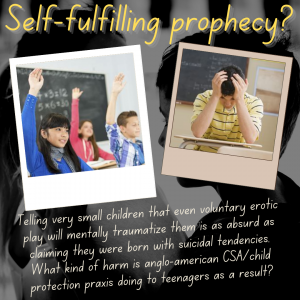One of our staff members is contributing considerably to a News Archiving service at Mu. Any well educated (Masters, PhD or above) users who wish to make comments on news sites, please contact Jim Burton directly rather than using this list, and we can work on maximising view count.
Self-fulfilling prophecy

The Self-fulfilling prophecy or causal loop is a regular factor in negotiating the pitfalls of MAP activism. Labeling theory explains much of what we observe, as do comparisons such as the dangers of black markets. We see these self-fulfilling prophecies in three main areas:
- Trauma and mental illness reported by MAPs and people (particularly women) with a history of minor-adult sex. In the latter case, the scarring (absent actual physical or psychological coercion) is caused by prior and retrospective social conditioning/iatrogenic harm. In turn, the cause of these harms is a system of stigmas and taboos on MAPs and Minor-Adult sex. Still, these outcomes are statistically insignificant - that is to say, there is no overall social trend towards said stereotypical reactions.
- Boldness, stubbornness and sometimes insanity among some of the more visible/activist MAPs (the Jack McClellan effect). By definition, if a mental or behavioral habit is reviled so widely by society, only the bravest, and some would say most insane will ever consider making themselves known on a voluntary basis.
- Low quality interactions, fetishization and poor self-control among the wider sample of people who engage in unlawful sex with a minor (regardless of MAP orientation). Again, if society despises and pathologizes the acts themselves, said acts are more likely to be committed by those who lack intelligence, self control or even fetishize the deviancy of their own acts. These individuals are far less likely to act with affection or respect for the other party. For example, well-publicised incidents involving recent migrants to Europe,[1] whose behavior would violate any definition of a western sexual assault law, regardless of legal age for sexual activity.
All of these phenomena were once highly visible among homosexual men, and in turn, used to justify their continued pathologization.
It is thought that higher visibility of MAPs will go some way towards addressing some of these imbalances.
"Counterintuitive" examples

There are many examples of self-fulfilling false prophecies.
One flip-side of the self-fulfilling prophecy, is the fact that while overall levels of offending are low, pro-c and anti-contact pedophiles are thought to exhibit no difference in their levels of offending (see Bailey for example). This is most probably because stridently anti-contact beliefs are associated with generally higher levels of conditioned guilt. Conditioned guilt (sex-shame) is in turn related to lower levels of self-control/higher impulsivity.[2] It could then be speculated that the number of pro-c individuals who philosophically justify what they see as an ethical form of offending, is roughly matched by the number of stridently anti-contact individuals whose beliefs represent a psychological reaction against their lack of self-control, hence their propensity to act.
Another example, is the (positive) subjective reactions of underage girls to penetrative sex with adults in the Finnish Victimization Survey, as investigated by Rind (2022) and Lahtinen (2018). These were in stark contrast to their negative experiences with non-penetrative sex (regardless of partner age). The reasons for this are thought to be related to girls' general unwillingness to agree to penetrative sex in what they consider to be awkward encounters with partners they are less familiar with.
Quotes
The harm, Ehman suggests, is the result of a self-fulfilling prophecy. In his view, adult-child sex is made traumatizing by a culture that labels it with strongly evaluative terms such as “abuse,” “assault,” and “molestation” and communicates to children that they have been scarred for life.[3]
See also
- Deviancy amplification spiral (Wikipedia)
- Debate Guide: All child molesters are pedophiles
- Research: Prevalence
- Research: Pedophiles in the criminal population
- Research: Association or Causation - Self fulfilling prophecy of harm.
- Research: Secondary Harm - Self fulfilling prophecy of harm.
- Incest: The Last Taboo - Self fulfilling prophecy of incest harm.
References
- ↑ Breitbart - Some playful, some forceful "culturally inappropriate" immigrant sex crimes
- ↑ Rendina HJ, López-Matos J, Wang K, Pachankis JE, Parsons JT. The Role of Self-Conscious Emotions in the Sexual Health of Gay and Bisexual Men: Psychometric Properties and Theoretical Validation of the Sexual Shame and Pride Scale. J Sex Res. 2019 May-Jun;56(4-5):620-631.
- ↑ Ole Martin Moen: Article on Pedophilia